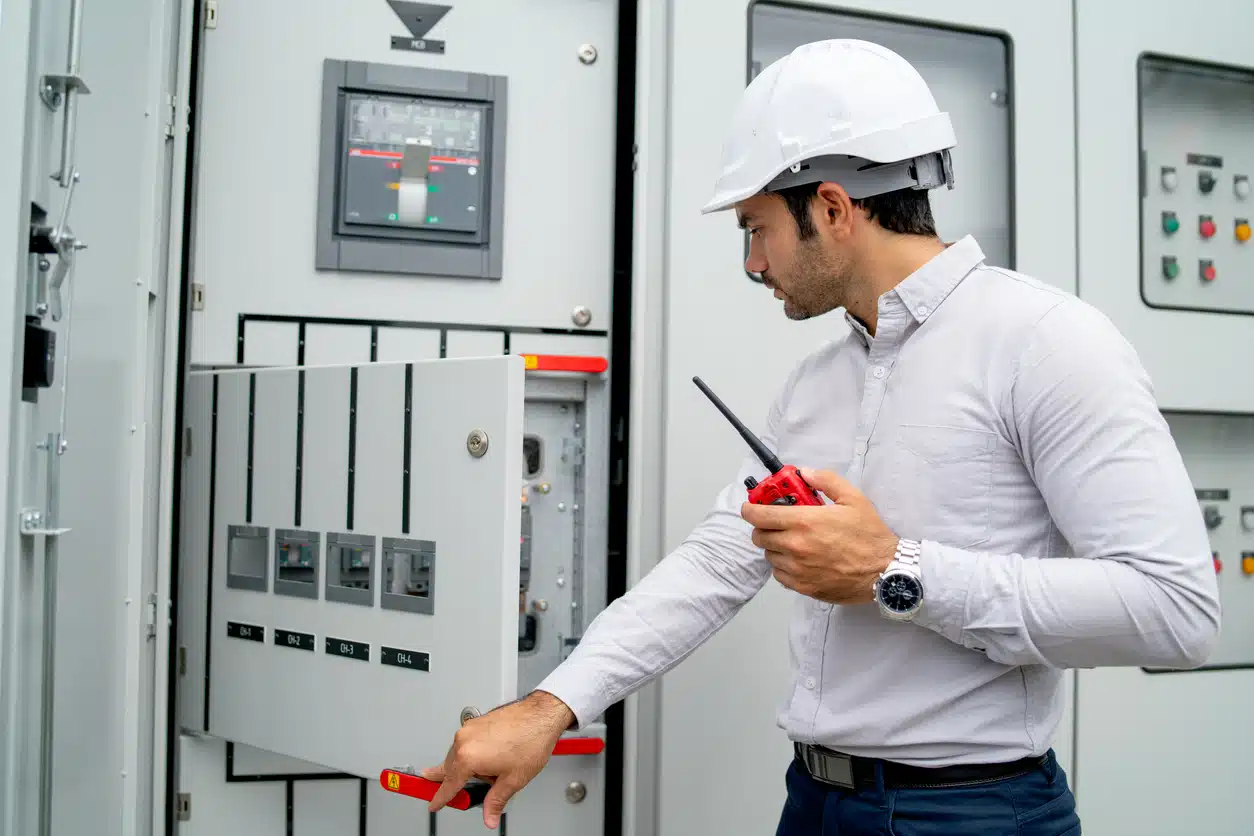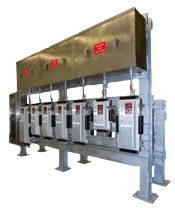
Retrofitting switchgear is a cost-effective way to modernize outdated systems without ripping out and replacing entire electrical lineups. But how do you know when a retrofit is the right move—and what’s at stake if you get it wrong?
Switchgear retrofits reuse key structural components of existing switchgear—like the cabinet, buswork, or enclosures—while upgrading the internal gear such as circuit breakers, relays, metering, and protection systems. This approach drastically reduces downtime and capital expenditure, especially for critical facilities like refineries and industrial plants where shutdowns can cost millions per day.
Retrofitting is most commonly pursued when:
-
- Replacement OEM components are obsolete or excessively expensive
- Facilities want to increase capacity, improve safety, or upgrade protection systems
- Downtime for complete replacement is not feasible
- Compliance with newer standards (IEEE, OSHA, NFPA 70E) is needed to avoid liability or insurance issues
According to IEEE C37.59-2018, a retrofit is not just a repair—it is considered a new design, which means it must be formally design verified through testing and documentation. This includes ensuring that mechanical interfaces (like racking mechanisms), electrical ratings, insulation systems, and interlocks all meet the required standards of performance and safety. The standard clearly states that relying on production tests alone is not enough—a new design requires engineering analysis and full test documentation.
The risks of getting it wrong are significant:
-
- Loss of UL/NRTL listings, making the gear legally non-compliant
- Increased arc flash risk if interlocks or breaker clearances are improperly retrofitted
- Voided insurance coverage for facilities that perform uncertified work
- Operational failures or outages caused by incompatibilities between legacy gear and modern breakers
Yet, many facilities unknowingly void their UL listing or NRTL certifications by hiring general contractors or unauthorized shops for retrofits. Once a component like a breaker or trip unit is swapped, the whole assembly becomes a new product—and that requires new compliance verification.
Spike Electric is uniquely positioned to handle this. As a certified manufacturer with in-house engineering, custom fabrication, and strong ties to NRTLs like UL and Intertek, we provide:
-
- Verified retrofits that maintain or improve original ratings
- Full documentation for OSHA and NFPA 70E compliance
- Custom adapters to integrate new gear into legacy equipment
- Shorter lead times and fewer shutdowns thanks to local Texas-based service
Common questions facilities ask — answered:
Can I upgrade switchgear without replacing it all?
Yes. Retrofitting allows you to modernize key internal components (breakers, relays, etc.) while keeping the existing cabinet, buswork, and structure. This approach reduces cost and downtime—if done properly by a certified manufacturer.
What’s the average lifespan of medium voltage switchgear?
Most medium voltage switchgear has a service life of 25–40 years, but factors like environment, load cycles, and maintenance can shorten or extend it. Retrofitting can significantly extend useful life without requiring full replacement.
Is switchgear retrofitting safe and code-compliant?
It can be—but only if it follows IEEE C37.59-2018 standards and is verified by a manufacturer working with UL or an NRTL. Spike Electric provides full compliance and documentation to meet OSHA, NFPA 70E, and NEC requirements.
What’s the difference between retrofitting and full replacement?
Retrofitting upgrades the internal operational components while keeping the existing enclosure and layout. Full replacement removes everything and requires completely new gear. Retrofitting is faster, more affordable, and less disruptive.
Who is qualified to certify a retrofit in Texas?
Only a UL-verified manufacturer or company working under a Nationally Recognized Testing Laboratory (NRTL) like UL or Intertek can certify that a retrofit meets code compliance. It’s a common misconception that having a degreed electrical engineer, a licensed contractor, or even a NETA-compliant testing technician is enough. While these professionals bring valuable knowledge, they are not authorized to certify switchgear retrofits under IEEE C37.59-2018.
To maintain or renew NRTL labeling, specialized internal testing must be performed—often at high-powered laboratories equipped to simulate fault conditions and verify interrupt ratings, dielectric withstand, and mechanical interlock performance. These labs work in coordination with manufacturers and NRTLs to validate new designs.
Manufacturers like Spike Electric, Eaton, Square D, and ABB have internal systems and certifications in place to support this process. That’s why working with a field service contractor alone is not sufficient. They can perform installation or maintenance—but not the design verification, certification, or documentation needed to maintain UL/NRTL status.
Spike Electric not only performs the retrofit—we back it with full design review, documentation, and coordination with UL or Intertek to ensure it meets national standards. That’s the difference between compliance and costly liability.Only a UL-verified manufacturer or company working under an NRTL can certify that a retrofit meets compliance. Spike Electric works with UL and Intertek to ensure every retrofit is backed by valid certification.
Can retrofitting improve arc flash ratings?
Yes. By upgrading to modern breakers and protection systems—and ensuring proper coordination—you can reduce arc flash energy and improve worker safety. Spike also integrates UFES and arc flash studies where needed.
Will my insurance provider accept a non-certified retrofit?
Most won’t. A non-certified retrofit can void your facility’s insurance policy or limit claim recovery in the event of a failure. Certified retrofits with proper documentation are the only safe option.
Can I keep my UL label after upgrading a breaker?
Only if the retrofit is reviewed and certified by a UL/NRTL-affiliated organization. Otherwise, the UL mark is void and cannot be used. Spike Electric ensures you maintain or renew UL/NRTL labeling as required.
Bottom Line:** If you’re considering a retrofit to extend the life of your electrical infrastructure, don’t risk it with uncertified upgrades. Contact Spike Electric for turnkey retrofit services that preserve certifications and ensure compliance with OSHA, IEEE C37.59-2018, and NFPA 70E.
The Truth About Arc Flash Ratings in Upgraded Switchgear
It’s easy to assume your equipment is still arc-resistant after a retrofit. It’s also dangerously wrong.
Arc-resistant switchgear is engineered to redirect the immense energy of an internal arc event away from personnel—often through ducted exhaust systems and reinforced enclosures. However, when switchgear is modified without revalidation of its arc-resistant design, the protection it once offered can be rendered completely ineffective.
According to IEEE C37.20.7 and C37.59, any claim of arc-resistant performance must be supported by full type testing—including internal arc-fault testing under lab conditions. These tests must be conducted on the exact equipment configuration post-modification. Changing breakers, adding viewing windows, altering compartment structure, or replacing insulation without manufacturer-backed testing invalidates the arc-resistant rating.
Many field service providers and electricians will unknowingly (or falsely) label modified gear as arc-resistant without testing. That’s not just misleading—it’s a serious liability. If an arc flash incident occurs and the gear wasn’t certified in its final form, the result can be catastrophic for personnel safety, legal liability, and insurance claims.
Spike Electric eliminates that risk. We design and perform validated upgrades that preserve or enhance arc-resistant performance. Our team engineers custom compartment layouts, conducts design reviews, and coordinates with UL, Intertek, or other NRTLs to verify that post-retrofit gear meets all applicable standards. If needed, we perform or coordinate full type testing to document compliance.
If your facility is regulated under NFPA 70E, OSHA 1910 Subpart S, or NEC 110.16, an invalid arc rating could put you out of compliance and expose your workers to serious harm. Don’t assume—verify.
Integrated questions:
-
- Does switchgear still meet arc flash standards after upgrades?
- What’s the difference between arc flash protection and arc-resistant gear?
- How do I keep my gear NFPA 70E compliant?
- Can you modify gear and retain arc-resistant ratings?
- What testing is needed to label gear as arc-resistant?


